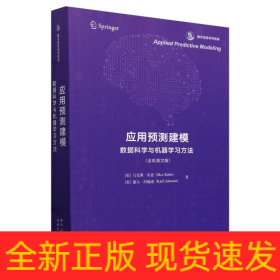
应用预测建模:数据科学与机器学习方法
全新正版 极速发货
¥ 142.11 6.5折 ¥ 219 全新
库存18件
广东广州
认证卖家担保交易快速发货售后保障
作者(美)马克斯·库恩//谢尔·约翰逊|
出版社世图出版公司
ISBN9787523211335
出版时间2024-03
装帧其他
开本其他
定价219元
货号31997739
上书时间2024-05-23
- 最新上架
商品详情
- 品相描述:全新
- 商品描述
-
目录
1 Introduction
1.1 Prediction Versus Interpretation
1.2 Key Ingredients of Predictive Models
1.3 Terminology
1.4 Example Data Sets and Typical Data Scenarios
1.5 Overview
1.6 Notation
Part I General Strategies
2 A Short Tour of the Predictive Modeling Process
2.1 Case Study: Predicting Fuel Economy
2.2 Themes
2.3 Summary
3 Data Pre-processing
3.1 Case Study: Cell Segmentation in High-Content Screening
3.2 Data Transformations for Individual Predictors
3.3 Data Transformations for Multiple Predictors
3.4 Dealing with Missing Values
3.5 Removing Predictors
3.6 Adding Predictors
3.7 Binning Predictors
3.8 Computing
Exercises
4 Over-Fitting and Model Tuning
4.1 The Problem of Over-Fitting
4.2 Model Tuning
4.3 Data Splitting
4.4 Resampling Techniques
4.5 Case Study: Credit Scoring
4.6 Choosing Final Tuning Parameters
4.7 Data Splitting Recommendations
4.8 Choosing Between Models
4.9 Computing
Exercises
Part II Regression Models
5 Measuring Performance in Regression Models
5.1 Quantitative Measures of Performance
5.2 The Variance-Bias Trade-off
5.3 Computing
6 Linear Regression and Its Cousins
6.1 Case Study: Quantitative Structure-Activity Relationship Modeling
6.2 Linear Regression
6.3 Partial Least Squares
6.4 Penalized Models
6.5 Computing
Exercises
7 Nonlinear Regression Models
7.1 Neural Networks
7.2 Multivariate Adaptive Regression Splines
7.3 Support Vector Machines
7.4 K-Nearest Neighbors
7.5 Computing
Exercises
8 Regression Trees and Rule-Based Models
8.1 Basic Regression Trees
8.2 Regression Model Trees
8.3 Rule-Based Models
8.4 Bagged Trees
8.5 Random Forests
8.6 Boosting
8.7 Cubist
8.8 Computing
Exercises
……
Part III Classification Models
Appendix
References
Indicies
Computing
General
内容摘要
本书专注于预测建模的实际应用,介绍了从数据预处理到建模再到模型评估和选择的整个过程,以及背后的统计思想,涉及各种回归技术和分类技术。从解决实际问题延伸到模型拟合,以及随之出现的主题,如处理类不平衡、选择预测因子等在实践中经常出现的问题,作者意在为读者提供预测建模过程的指导,并结合开源软件R语言来求解实际问题,详细给出R代码和处理的步骤。
相关推荐
— 没有更多了 —















以下为对购买帮助不大的评价